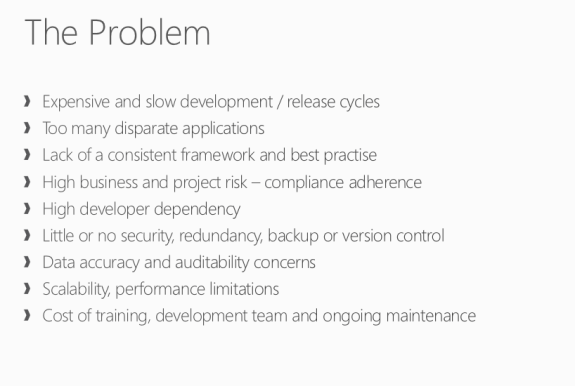Please note that this article has been updated. You can find the updated article here.
I recently put together a presentation on Microsoft Dynamics CRM as a platform. I can’t share the entire deck, but I have been able to pull out three slides for this article. The concept of Microsoft Dynamics CRM as a platform has been around for many years and in that time I have had the pleasure of building three products on the platform:
- A Hedge Fund / Asset Management system (Investor Relations, Fund & Investor Flows, Investor Reporting, Nominee and Custodian relationships)
- A Corporate Banking CRM system (Wallet Share, Research, Call Reports, Client Reporting, Account Planning, Client & Product On Boarding)
- A Data Residency Solution (Data residing within geographic region such as Switzerland)
I can’t imagine building the above as a greenfield project and by choosing to use Microsoft Dynamics CRM I was able to very quickly focus my efforts on the business needs of my customers and potential customers rather than worrying about technology. I hope the slides below help you to understand the reasons why I chose to use Microsoft Dynamics CRM as a platform.
When thinking about Microsoft Dynamics CRM as a platform I think it is worth thinking about two primary cases:
- Extended relationship Management – building out the platform to provide functionality beyond traditional sales, marketing and services to all those parts of the business that manage relationships: Clients, Suppliers, Counterparties, Stakeholders, or anyone or anything that involves point to point interaction and communication.
- Application Rationalisation – replacing legacy systems that have been built greenfield or replacing complex Access databases, Excel spread sheets, Lotus Notes applications etc.
The Problem – Slide 1
- Expensive and slow development / release cycles
- Too many disparate applications
- Lack of a consistent framework and best practise
- High business and project risk – compliance adherence
- High developer dependency
- Little or no security, redundancy, backup or version control
- Data accuracy and auditability concerns
- Scalability, performance limitations
- Cost of training, development team and ongoing maintenance
The Dynamics Solution – Slide 2
- Reduce Costs – By rationalizing on a single platform and taking advance of the native features Microsoft Dynamics enables you to reduce hidden costs
- Faster Rollout – With many features of out the box and an extensible point and click customization engine developers and business analytics can make complex line-of-business- applications without starting from scratch
- Mitigate Risks – With less to build and complex non functional requirements already in place (infrastructure definition, redundancy, high availability strategies, etc) the development team can focus on business and functional needs and deliver of time
- Enhanced Automation – the Dynamics platforms provides rich automation features out of the box and is based on the well known Windows Workflow Foundation so that developers and business analysts can further automate your business
- Integration – Microsoft dynamics provides many integrations to other Microsoft products (Office, Outlook, SharePoint, Lync etc) it is based on Microsoft SQL server and the platform architecture and fully documented SDK provides complex integration capabilities with back office systems using Custom .NET plugins and web services
- Native Features – Microsoft provides many benefits beyond traditional CRM features (Sales, Marketing, Support) Platform capabilities such as Mobility, Social, Business Process Mgmt, Business Intelligence, Outlook/Office/Lync, Configuration, Extensibility, Role based Security, Auditing, Deployment, Scalability, Manageability, Data Cleansing, Upgrade means that you team can focus on the features that deliver the most value to your business.
- Usability – Microsoft Dynamics provides a consistent well known user interface. And is immediately familiar to any Microsoft Office Users. Furthermore the platform allows users to access the system through many different method: Browser, Mobile, Tablet, Online, Offline, Outlook
- Scalability – The Microsoft Dynamics platform has over 3M Users and over 33,000 customers. Technical whitepapers fully that document heavy usage and infrastructure requirements such as 100,000 concurrent users with sub second performance. The platform gives you proven high availability, redundancy, security and backup strategies right out of the box.
Slide 3
This posting is provided “AS IS” with no warranties, and confers no rights.
Next week on Mark Margolis’s Blog: The Developer Desktop



Excellent blog post. I absolutely appreciate this site.
Keep it up!